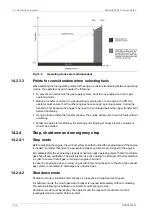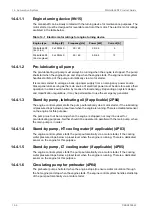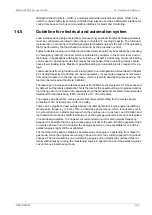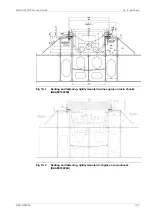
13.
Exhaust Emissions
Exhaust emissions from the dual fuel engine mainly consist of nitrogen, carbon dioxide (CO2)
and water vapour with smaller quantities of carbon monoxide (CO), sulphur oxides (SOx) and
nitrogen oxides (NOx), partially reacted and non-combusted hydrocarbons and particulates.
13.1
Dual fuel engine exhaust components
Due to the high efficiency and the clean fuel used in a dual fuel engine in gas mode, the exhaust
gas emissions when running on gas are extremely low. In a dual fuel engine, the air-fuel ratio
is very high, and uniform throughout the cylinders. Maximum temperatures and subsequent
NOx formation are therefore low, since the same specific heat quantity released to combustion
is used to heat up a large mass of air. Benefitting from this unique feature of the lean-burn
principle, the NOx emissions from the Wärtsilä DF engine is very low, complying with most
existing legislation. In gas mode most stringent emissions of IMO, EPA and SECA are met,
while in diesel mode the dual fuel engine is a normal diesel engine.
To reach low emissions in gas operation, it is essential that the amount of injected diesel fuel
is very small. The Wärtsilä DF engines therefore use a "micro-pilot" with less than 1% diesel
fuel injected at nominal load. Thus the emissions of SOx from the dual fuel engine are
negligable. When the engine is in diesel operating mode, the emissions are in the same range
as for any ordinary diesel engine, and the engine will be delivered with an EIAPP certificate to
show compliance with the MARPOL Annex VI.
13.2
Marine exhaust emissions legislation
13.2.1
International Maritime Organization (IMO)
The increasing concern over the air pollution has resulted in the introduction of exhaust
emission controls to the marine industry. To avoid the growth of uncoordinated regulations,
the IMO (International Maritime Organization) has developed the Annex VI of MARPOL 73/78,
which represents the first set of regulations on the marine exhaust emissions.
The IMO Tier 3 NOx emission standard will enter into force from year 2016. It will by then apply
for new marine diesel engines that:
●
Are > 130 kW
●
Installed in ships which keel laying date is 1.1.2016 or later
●
Operating inside the North American ECA and the US Caribbean Sea ECA
From 1.1.2021 onwards Baltic sea and North sea will be included in to IMO Tier 3 NOx
requirements.
13.2.2
Other Legislations
There are also other local legislations in force in particular regions.
13.3
Methods to reduce exhaust emissions
All standard Wärtsilä engines meet the NOx emission level set by the IMO (International Maritime
Organisation) and most of the local emission levels without any modifications. Wärtsilä has
also developed solutions to significantly reduce NOx emissions when this is required.
Diesel engine exhaust emissions can be reduced either with primary or secondary methods.
The primary methods limit the formation of specific emissions during the combustion process.
DBAD209883
13-1
13. Exhaust Emissions
Wärtsilä 46DF Product Guide
Summary of Contents for 46DF
Page 1: ...W rtsil 46DF PRODUCT GUIDE...
Page 4: ...This page intentionally left blank...
Page 8: ...This page intentionally left blank...
Page 16: ...This page intentionally left blank...
Page 118: ...This page intentionally left blank...
Page 140: ...This page intentionally left blank...
Page 148: ...This page intentionally left blank...
Page 174: ...This page intentionally left blank...
Page 186: ...This page intentionally left blank...
Page 198: ...This page intentionally left blank...
Page 206: ...This page intentionally left blank...
Page 214: ...This page intentionally left blank...
Page 218: ...This page intentionally left blank...
Page 230: ...This page intentionally left blank...
Page 234: ...This page intentionally left blank...
Page 236: ...This page intentionally left blank...
Page 241: ...Fig 21 7 List of symbols DAAF406507 7 DBAD209883 21 5 21 ANNEX W rtsil 46DF Product Guide...
















































